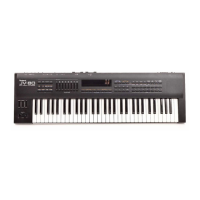4.System Common
Parameters
CONTROL
Output
mode Settings: OFF/lNT/MIDI/I + M
This determines the destination of
the data which is controlled by the pedals or CI
slider. The INT setting sends the
data to the
internal sound source only. The MIDI setting sends
the
data
only to the MIDI OUT
terminal. The
I +
M
setting sends the data to both the internal
sound source
and the MIDI
OUT terminal. It does
not function when set to
OFF.
Foot pedal 2
I
Foot pedal 1
CI slider
INT
Internal
sound
source
I+M
MIDI
MIDI OUT
Assign Assign
Settings :
CCO
—
CC95/AFTERTOUCH/BEND-UP/BEND-DOWN/PROG-UP/PROG-DOWN
This determines the parameters which are
controlled
by the pedals or CI
slider. The CCO
—
CC95
setting switches
among MIDI control
change numbers
—
95. The AFTERTOUCH
setting corresponds to
aftertouch. The
BEND-UP/BEND-DOWN settings correspond to pitch bend lip and down. And
the PROG-UP/PROG-DOWN
setting selects the next
Performance/Patch number. The value in parentheses
(
)
indicates the current
value
of
the
pedal/Cl slider.
PEDAL POLARITY Page
PEDl=lL t
Ped.3lll Pedal2l Hold
POLi^^RITVtSTi^^NDflRD I STfiHDflRD I
REUERSE
PEDAL 1 PEDAL 2 HOLD Settings: STANDARD/REVERSE
This
parameter
lets you
set the JV-80 so that it matches the polarity of the
pedal switch connected to pedal jacks 1
and 2 and the hold pedal jack.
Set it
to STANDARD
when using a Roland pedal
switch
(DP-2).
Set it to REVERSE when using other manufacturers' pedal
switches that have
reverse polarity. (For example, a
pedal with reverse polarity connected to the hold pedal jack would sustain
the sound when the pedal is
not pressed.)
AFTERTOUCH
Page
FtFTER
TOUCH
t Thresh!
H l@l
74

